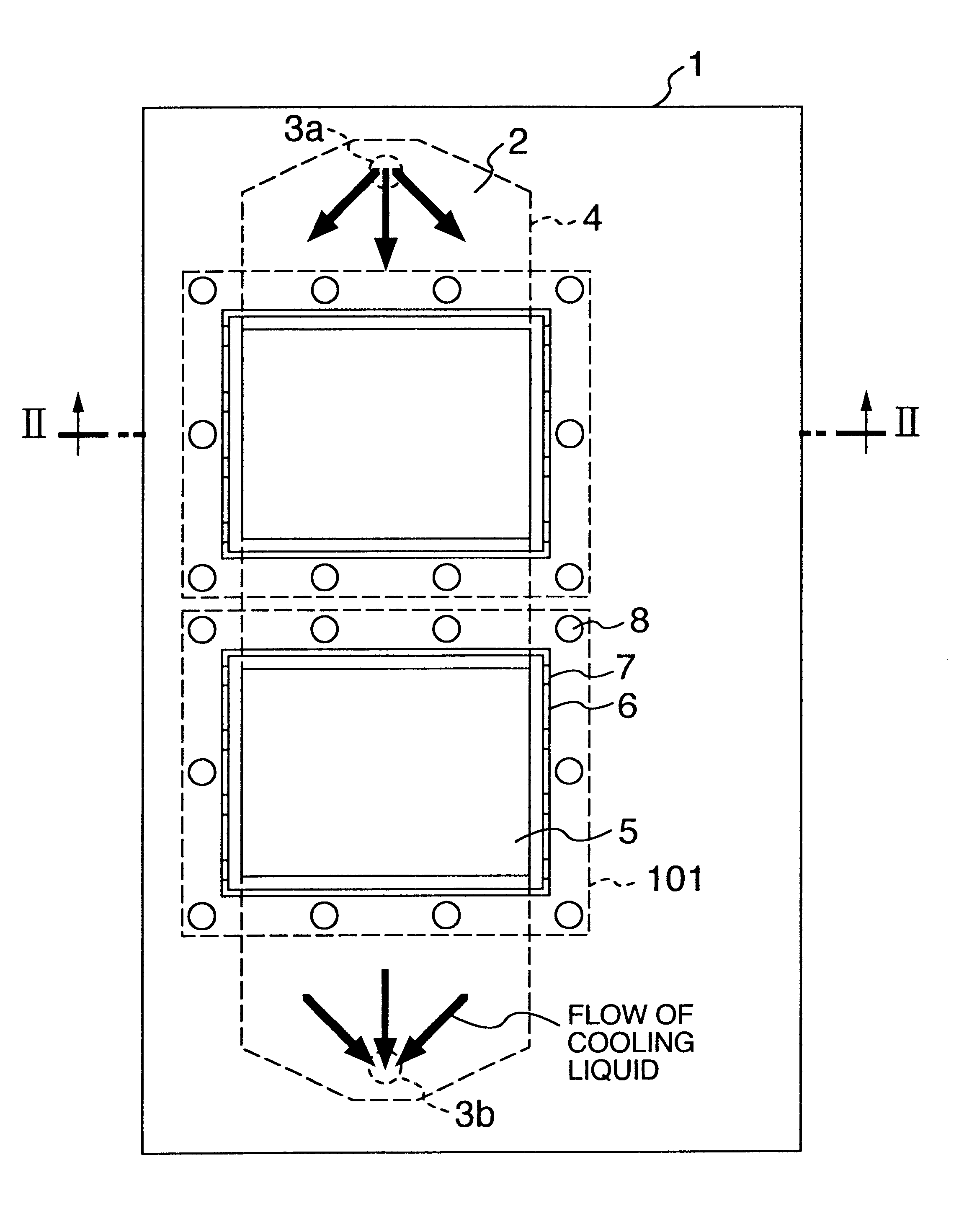Power inverter
a technology of power inverter and sealing portion, which is applied in the direction of electrical apparatus construction details, solid-state devices, semiconductor devices, etc., can solve the problems of difficult maintenance of such a power inverter, liquid may leak to the circuit substrate side from the degraded sealed portions, etc., to achieve excellent cooling performance, prevent leakage, and reduce the size of the apparatus
- Summary
- Abstract
- Description
- Claims
- Application Information
AI Technical Summary
Benefits of technology
Problems solved by technology
Method used
Image
Examples
first embodiment
the power inverter of the present invention will be described with reference to FIGS. 1 to 4. FIG. 1 is a view showing a configuration of a cooling section of a power inverter module according to a first embodiment of the present invention. FIG. 2 is a sectional view taken along a line II--II in FIG. 1. FIG. 3 is a sectional view taken along a line III--III in FIG. 2. FIG. 4 is a sectional view taken along a line IV--IV in FIG. 2.
This embodiment shows a power inverter for a hybrid vehicle and shows an example of a case where two respectively independent inverter circuits are mounted to control two revolving electric apparatus. These drawings principally show semiconductor modules and heat sinks (cooling cases or substrates) for cooling the semiconductor modules and omit description of other electric parts such as a capacitor and a microcomputer control circuit, wiring, and parts. electric parts such as a capacitor and a microcomputer control circuit, wiring, and others.
First, the co...
second embodiment
Next, the power inverter of the present invention will be described with reference to FIG. 5. FIG. 5 is a sectional view of cooling structure for the semiconductor modules.
This embodiment differs from the first embodiment in that clamping bolts 106b are provided in the pressure contact areas of the first seal portion 9. It should be noted that for the clamping bolts in the first seal portion 9, through-holes are formed in the heat sink 1, while internal thread holes are formed in the radiating plate 104 but processed so as not to penetrate through the substrate into the case for the semiconductor modules. These bolts chiefly serve to obtain an appropriate surface pressure in the pressure contact areas of the first seal portion and to improve the distribution of surface pressure, thereby further improving the sealing performance. In addition, since the internal thread holes do not penetrate the radiating plate 104, the possibility that the liquid will leak into the semiconductor modu...
third embodiment
the power inverter of the present invention will be described with reference to FIG. 6. FIG. 6 is a sectional view of cooling structure for the semiconductor module.
This embodiment differs from the first embodiment in that leakage sensors 11 are provided in each groove 6. The leakage sensors 11 detect leakage to issue, for example, an alarm signal to a driver or stop the operation of the power inverter. Also in this case, in order to prevent the pressure of the liquid from being applied to the second seal portion, the groove 6 also has the holes 7 discretely provided at the bottom of the grooves 6, which are in communication with an atmosphere outside the apparatus. With this configuration, it is possible to protect the power inverter before the adverse effects of a failure or the like resulting from the leakage propagate to other parts.
PUM
 Login to View More
Login to View More Abstract
Description
Claims
Application Information
 Login to View More
Login to View More - R&D
- Intellectual Property
- Life Sciences
- Materials
- Tech Scout
- Unparalleled Data Quality
- Higher Quality Content
- 60% Fewer Hallucinations
Browse by: Latest US Patents, China's latest patents, Technical Efficacy Thesaurus, Application Domain, Technology Topic, Popular Technical Reports.
© 2025 PatSnap. All rights reserved.Legal|Privacy policy|Modern Slavery Act Transparency Statement|Sitemap|About US| Contact US: help@patsnap.com



